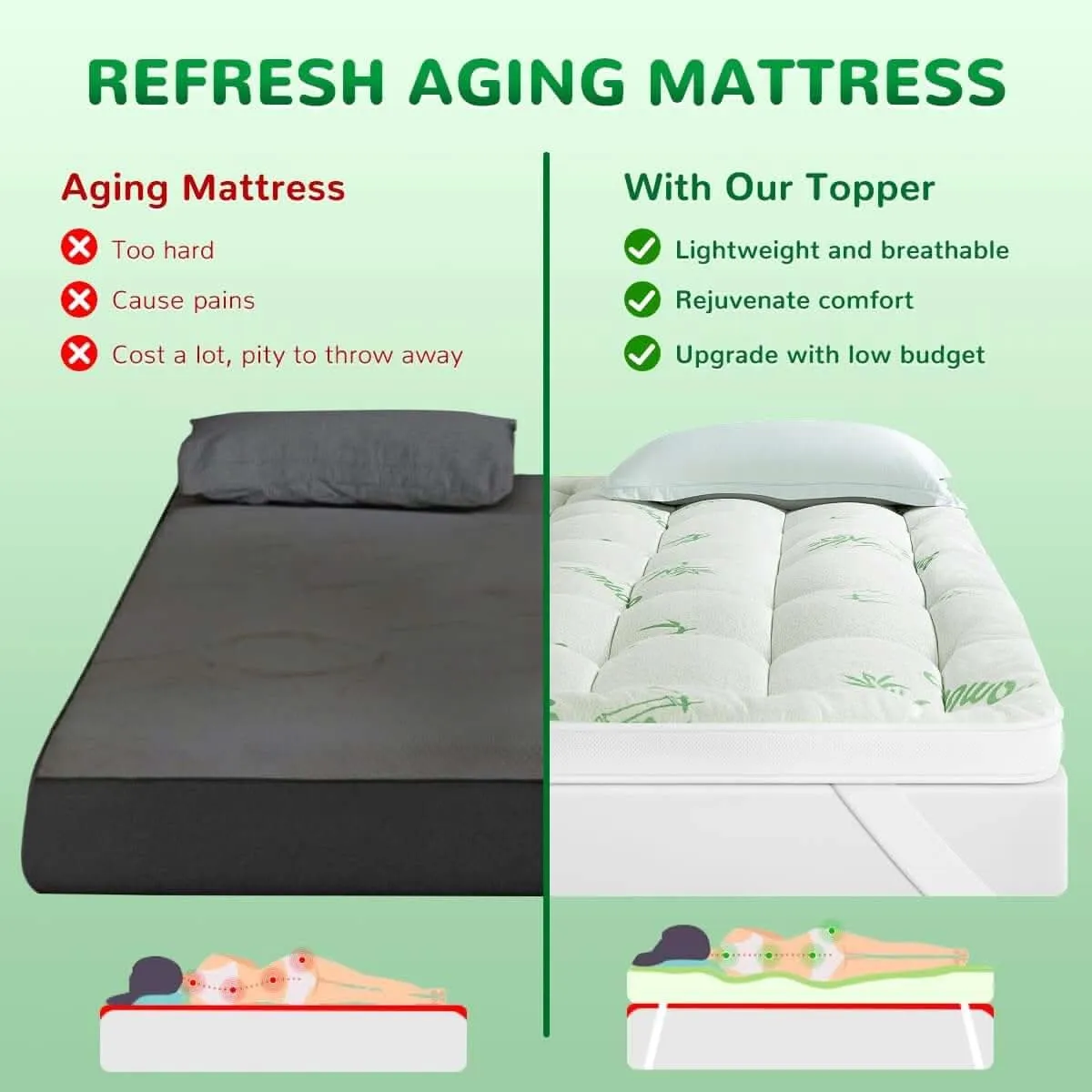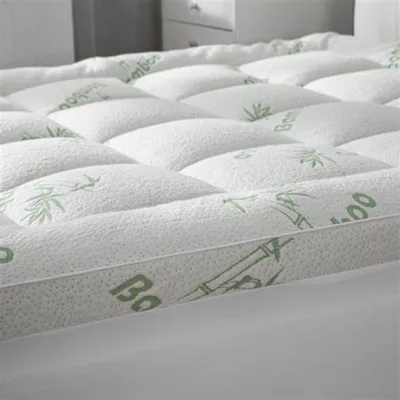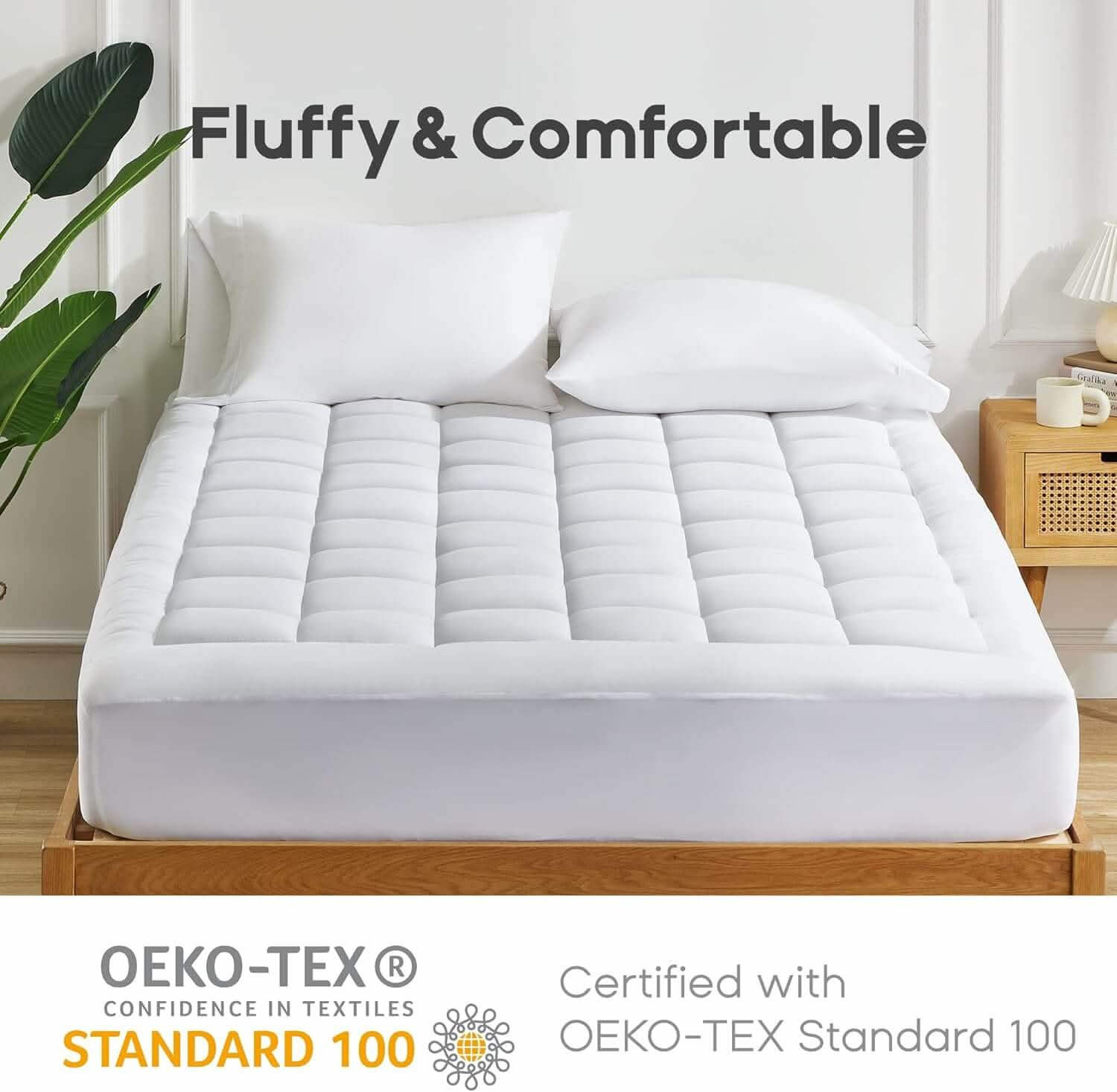Sleep Eco-Friendly with Bamboo Mattress Toppers in Australia: Your Complete Guide to Hypoallergenic, Cooling, and Sustainable Comfort
Bamboo mattress toppers are a breathable, eco-friendly layer that sits atop your mattress to enhance comfort, regulate temperature, and reduce allergen exposure. These toppers typically combine a bamboo-derived viscose cover with a fibre or foam fill, and their natural moisture-wicking and breathable structure helps keep sleepers cooler and drier—a useful trait for many Australian climates. This guide explains how bamboo toppers work, what materials and certifications to look for, and how they compare to common alternatives like memory foam and latex. You will also find practical buying advice on sizes, thicknesses and GSM, clear care instructions to extend lifespan, and targeted guidance for allergy sufferers and hot sleepers. First, we define the product and its components, then we examine hypoallergenic benefits and thermal performance, proceed to purchasing criteria and care, and finish by outlining what makes EcoToppers’ Hypoallergenic Bamboo Mattress Topper a relevant real-world example for Australian shoppers.
What Is a Bamboo Mattress Topper and Why Choose It for Eco-Friendly Sleep in Australia?
A bamboo mattress topper is a bedding accessory made from bamboo-derived materials that enhance surface comfort and thermal regulation on an existing mattress. The core reason bamboo works is its viscose-from-bamboo cover combined with breathable fill layers; this pairing increases airflow and wicks moisture away from skin, producing a cooler sleep surface and reduced humidity at the mattress interface. Choosing bamboo supports sustainability goals because bamboo grows rapidly and typically requires fewer pesticides and less water than conventional crops used in textiles. Understanding these basic materials and construction choices helps Australian buyers match toppers to local seasons and personal needs, which we explore in the following subsections.
What materials make up a bamboo mattress topper?

Bamboo mattress toppers are usually constructed from three main parts: an outer bamboo viscose cover, an inner fill layer (bamboo fibre or blended fibre fill), and attachment features such as elastic skirts or straps to secure the topper to a mattress. Bamboo viscose covers provide a soft, silky hand-feel and are prized for breathability, while fibre fills deliver plush cushioning without dense heat retention. Some toppers add thin memory foam or foam-infused layers to improve contouring and pressure relief; these hybrid constructions balance the breathability of bamboo with the support of foam. Choosing between an all-fibre bamboo topper versus a foam-infused option depends on desired feel, heat sensitivity, and maintenance preferences, which we examine later.
How does bamboo contribute to sustainable and eco-friendly bedding?
Bamboo contributes to sustainability through fast growth rates and typically low input requirements, meaning bamboo plantations can produce fibre more quickly and with less irrigation and pesticide use than many conventional crops. The conversion process from bamboo to viscose or rayon does involve chemical processing, so certified supply chains and manufacturing standards matter when assessing overall sustainability. Consumers benefit from looking for clear labels and independent certifications that validate lower environmental impact and safer processing methods. Knowing how sourcing and production affect environmental outcomes empowers Australian buyers to prioritise genuinely eco-friendly bedding choices that align with local sustainability goals.
What makes bamboo mattress toppers suitable for Australian climates?
Bamboo mattress toppers suit a range of Australian climates because their breathable cover and moisture-wicking fill help manage humidity in coastal and tropical regions while still offering insulating properties in cooler, temperate zones. In hot, humid summers, the topper’s ability to move sweat away from the skin and promote airflow reduces the microclimate warmth that exacerbates night sweats. In cooler months, a dry bamboo layer can retain comfortable insulation without the heavy heat-trapping typical of dense foams, making these toppers adaptable year-round. Considering seasonal variability helps you choose the right thickness and fill to match local conditions and personal comfort preferences.
What Are the Key Benefits of Hypoallergenic Bamboo Mattress Toppers?
A hypoallergenic bamboo mattress topper reduces allergen exposure primarily through its breathable structure, moisture control and surface properties that are less hospitable to dust mites, mould and certain bacteria. The mechanism is simple: by limiting trapped moisture and improving airflow, bamboo-derived tops reduce the damp, warm environment where allergens proliferate, which can lead to fewer nighttime symptoms for sensitive sleepers. Additional benefits include pressure-distribution for improved comfort, a soft surface favourable to sensitive skin, and generally easy-care maintenance that supports long-term hygiene. Below, we compare core benefit attributes across bamboo and common alternatives to illustrate these differences.
Bamboo toppers deliver several direct benefits for health and sleep:
- Hypoallergenic surface: Bamboo viscose is less likely to trap allergens and resists dust mite habitats through moisture control.
- Temperature regulation: Breathability and moisture-wicking reduce heat retention that commonly disturbs sleep.
- Comfort and pressure relief: Fibre or hybrid fills cushion joints and help distribute pressure for better alignment.
These benefits combine to make bamboo a practical choice for allergy-prone Australians who want sustainable bedding without sacrificing comfort. The next subsection explains how bamboo resists common allergens at a micro-environment level.
| Topper Type | Key Allergen-Related Attribute | Practical Benefit |
|---|---|---|
| Bamboo (viscose + fibre) | High breathability, moisture-wicking | Reduces dust mite and mould growth potential |
| Memory foam | Dense structure, low airflow | Can trap heat and moisture, increasing allergen risk |
| Latex | Naturally resistant to dust mites (depending on processing) | Good resistance but varies by blend and cover |
| Wool | Naturally breathable and moisture-regulating | Good at resisting mould and mites when treated |
How do bamboo mattress toppers resist dust mites, mould, and bacteria?
Bamboo toppers reduce microbial and allergen risk primarily through moisture management and surface properties that limit breeding environments for dust mites and mould. The breathable viscose cover and porous fill promote evaporation, keeping the sleeping surface drier and less attractive to mites that thrive in humid conditions. Some bamboo-derived fibres also exhibit natural anti-microbial tendencies or are manufactured with treatments that further suppress bacterial growth, though buyer attention to processing and certification is important. Maintaining proper care—regular airing, using protectors and following washing guidance—amplifies these innate properties and helps sustain hypoallergenic performance over time.
Can bamboo toppers improve sleep quality for allergy sufferers?
For many allergy sufferers, a bamboo mattress topper can reduce nighttime irritation by lowering exposure to triggers such as dust mite fragments and mould spores, which often reside in mattresses and bedding. Reduced allergen load typically leads to fewer awakenings, less congestion, and more consolidated sleep, which in turn improves daytime functioning and restorative sleep cycles. While individual responses vary, practical outcomes commonly include decreased nasal symptoms, fewer skin irritations and a perceived improvement in sleep continuity. When symptoms are severe or tied to chronic respiratory issues, bamboo toppers are a supportive measure but are not a substitute for medical care.
What pressure relief and comfort advantages do bamboo toppers provide?
Bamboo toppers provide cushioning that helps distribute pressure across shoulders, hips and lower back, improving contact comfort for side and back sleepers in particular. Fill thickness and material (fibre vs foam-infused) determine how much contouring and support you receive; thicker fibre fills increase plushness while foam layers add targeted contouring capacity. For sleepers with mild back pain, a medium-thickness bamboo topper can relieve pressure points and improve perceived alignment on an otherwise firm mattress, whereas heavier sleepers may need firmer or thicker solutions. The following table summarises these benefit trade-offs across typical topper types.
| Topper Type | Attribute | Value |
|---|---|---|
| Bamboo fibre | Pressure distribution | Moderate cushioning with fast recovery |
| Foam-infused bamboo | Contouring | Higher pressure relief, moderate thermal retention |
| Latex core with bamboo cover | Responsiveness | Strong support with natural resilience |
| Thick fibre (>4cm) | Support for heavier sleepers | Better at masking mattress sag and distributing weight |
After H2: As a concise, practical product example that illustrates many of these benefits, EcoToppers offers a Hypoallergenic Bamboo Mattress Topper designed to combine breathable bamboo viscose covers with a hypoallergenic fibre fill to promote cooling and reduce allergen exposure. This product example shows how hypoallergenic and temperature-regulating attributes can be delivered in a single topper option suitable for Australian buyers seeking sustainable, easy-care bedding.
How Do Cooling Bamboo Mattress Toppers Regulate Temperature for Hot Sleepers in Australia?
Cooling bamboo mattress toppers regulate temperature by increasing airflow at the mattress surface and transporting moisture away from skin, which enhances evaporative cooling and reduces heat retention. The porous microstructure of bamboo viscose and open-fibre fills allows convective air movement, while moisture-wicking draws sweat away so evaporation can remove heat efficiently. Compared with dense memory foam, bamboo-based toppers typically feel cooler to the touch and maintain a drier sleeping microclimate. The following table clarifies how bamboo compares on three practical thermal attributes.
| Material | Thermal Property | Practical Effect |
|---|---|---|
| Bamboo viscose + fibre | High breathability, moisture-wicking | Cooler sleeping surface, less night sweat |
| Memory foam | Low breathability, heat retention | Can increase core temperature and discomfort |
| Latex | Moderate breathability, good resilience | Balanced warmth control, responsive feel |
What is the science behind bamboo’s breathability and moisture-wicking?
Bamboo viscose fibres are long and porous, creating tiny channels that facilitate airflow and capillary action to draw moisture away from the body toward the outer surface for evaporation. This mechanism reduces the insulating layer of warm, humid air that commonly forms between skin and bedding, thereby lowering perceived heat. The resulting increase in evaporative heat loss is the key reason bamboo toppers often feel cooler than dense foam alternatives. Understanding this mechanism helps shoppers prioritise breathable covers and open-fill structures when shopping for "breathable bamboo mattress pad Australia" or similar keywords.
How do bamboo fibres keep you cool in summer and warm in winter?
Bamboo fibres adapt to moisture conditions: when you sweat, the topper’s moisture-wicking promotes evaporation that cools; when the air is dry and cool, the drier fibres provide modest insulation without the heavy heat trap of thick foams. This dynamic thermal behaviour means bamboo toppers offer seasonal adaptability—effective cooling in humid Australian summers and sufficient warmth during cooler months when humidity is low. Selecting appropriate thickness and combining the topper with breathable bedding layers maximises seasonal comfort across diverse Australian climates.
Are bamboo mattress toppers better than memory foam or latex for hot sleepers?
Bamboo toppers outperform memory foam for hot sleepers because they permit more airflow and remove surface moisture more effectively, making them a better first choice for those prioritising cooling. Latex offers a middle path: natural latex can be breathable and responsive, offering cooling benefits while providing stronger support than fibre-only toppers, but its performance depends on processing and core design. Memory foam provides superior contouring and pressure relief but tends to trap heat; hybrid foam-in-bamboo designs can mitigate this by pairing breathable covers with thin foam layers for contouring without excessive warmth. The next section will translate this material trade-offs into buying guidance for Australian shoppers.
How to Choose the Best Bamboo Mattress Topper in Australia: Sizes, Thickness, and Material Options
Choosing the right bamboo mattress topper involves aligning size, thickness and GSM with your mattress condition, sleeping position and thermal needs. The core decision rules are simple: match topper size to mattress size to maintain fit; choose thickness based on mattress sag and sleeper weight; and select GSM and blends that balance durability with softness. Considering standard Australian mattress dimensions and common thickness ranges helps quick decision-making, and the following table offers targeted recommendations for different sleeper profiles.
| Sleeper Type | Thickness Recommended | Rationale |
|---|---|---|
| Light sleepers (<65kg) | 2–3 cm | Adds surface softness without excess sink |
| Average sleepers (65–90kg) | 3–5 cm | Improves comfort and modest pressure relief |
| Heavy sleepers (>90kg) | 5–8 cm | Masks mattress sag, provides better weight distribution |
What size and thickness options are available for bamboo mattress toppers?
Bamboo mattress toppers are sold in standard Australian mattress sizes and typically range from about 2 cm for light, comfort-layer toppers up to 8 cm for thick comfort and support. Thinner toppers suit sleepers seeking a silkier surface or mild pressure relief, while thicker toppers better mask mattress imperfections and offer deeper cushioning for side sleepers and heavier individuals. When choosing thickness, consider mattress depth and whether the topper’s elastic skirt will fit securely—a secure fit prevents movement and maintains consistent performance. The subsequent subsection discusses GSM and blend choices that determine longevity.
How do GSM and bamboo blends affect comfort and durability?
GSM (grams per square metre) measures fibre density; higher GSM in a bamboo fibre fill generally indicates greater durability, firmer support and longer-lasting loft, while lower GSM yields a softer, airier feel. Blends that pair viscose-from-bamboo covers with denser fibre fills or thin foam layers change the tactile experience: viscose gives smoothness, fibre fill keeps breathability, and foam adds contouring. For most Australian sleepers, a mid-range GSM paired with a 3–5 cm thickness balances comfort and longevity; if durability is paramount, select higher GSM and blended constructions designed to maintain loft. The next subsection weighs the pros and cons of memory foam-infused bamboo options.
Should you consider memory foam-infused bamboo toppers?
Memory foam-infused bamboo toppers combine the cooling cover and breathable fill with a thin memory foam core to increase pressure relief and contouring, making them attractive for sleepers needing targeted support. The trade-off is that foam layers can retain heat, so ensure the foam is ventilated or paired with breathable gel or open-cell structures to mitigate warmth. Foam-infused options suit people seeking both enhanced pressure relief and a cooler surface than pure foam, but pure fibre bamboo toppers remain a better choice for those prioritising maximum breathability. Choosing between these depends on whether contouring or cooling is your principal goal.
After H2: For Australian shoppers evaluating specific options, EcoToppers provides sizing and thickness choices across their Hypoallergenic Bamboo Mattress Topper range, offering multiple thickness levels and material blends so buyers can match topper depth and GSM to their mattress and sleep style. This practical example shows how product ranges help consumers select the right balance of cushioning, breathability and durability.
How to Care for Your Bamboo Mattress Topper: Washing, Maintenance, and Longevity Tips

Proper care preserves the hypoallergenic properties, breathability and structural integrity of bamboo mattress toppers, extending useful life and maintaining comfort. Care involves routine airing, use of mattress protectors, regular rotation, and following manufacturer washing guidelines where applicable. Small, consistent maintenance steps reduce moisture accumulation and prevent the conditions in which mould and dust mites thrive. The following list summarises essential care actions and is followed by practical explanations to help you implement an easy maintenance schedule.
Essential care steps for bamboo toppers:
- Use a breathable mattress protector to block spills and reduce direct soiling.
- Air the topper regularly, ideally in sunlight for short periods to help moisture evaporation.
- Rotate the topper every 4–8 weeks to distribute wear evenly and maintain loft.
- Spot-clean spills promptly with gentle detergent and allow full air-dry before reuse.
Implementing these steps helps keep a bamboo topper hygienic and functional, and the next subsections cover machine washing, maintenance scheduling and storage in more detail.
Can you machine wash a bamboo mattress topper safely?
Machine washability depends on construction: many topper covers are machine-washable, while full toppers with thick fibre or foam fills often require spot cleaning or professional cleaning to avoid damage. When machine washing is permitted, use gentle cycles, cold water and mild detergents to protect viscose fibres; avoid tumble-drying unless the care label explicitly allows low-heat tumble settings. Thorough air-drying is critical—compressing a damp topper can trap moisture and encourage mildew. When in doubt, remove the cover for machine washing and follow the manufacturer’s instructions to preserve fibre integrity and hypoallergenic properties.
What maintenance practices extend the life of bamboo toppers?
Regular maintenance that extends lifespan includes using a mattress protector, airing the topper weekly to shed moisture, rotating it to prevent uneven compression and addressing spills immediately with spot-clean techniques. Deep-cleaning should be infrequent and follow product guidance—for fibre fills, gentle hand-wash or professional cleaning is often safest. Avoid folding or compressing the topper for extended periods, as this can degrade fill structure and reduce loft. Establishing a simple schedule—weekly airing, monthly rotation and immediate spot-cleaning—keeps performance consistent over years rather than months.
How to store your bamboo mattress topper when not in use?
When storing a bamboo topper, use a breathable storage bag or cotton cover and avoid vacuum-sealed compression, which can damage loft and trapping residual moisture can promote mould. Store in a cool, dry place away from direct sunlight to prevent UV degradation of fibres and avoid attics or damp basements that experience high humidity. Allow the topper to be completely dry before storing, and check it periodically while stored to ensure no moisture or pests have affected it. Proper storage preserves shape and function for occasional use or seasonal rotation.
What Makes EcoToppers Bamboo Mattress Toppers Unique in Australia?
How does EcoToppers ensure Australian-made quality and sustainability?
EcoToppers positions its manufacturing and quality oversight within Australia, referencing production links to Victoria (Penshurst) as part of its local-quality claim; this local connection supports closer quality control and faster responsiveness to product issues. The family-run nature of the business is framed as contributing to hands-on oversight of materials and manufacturing choices, with attention to sustainable materials like bamboo viscose and hypoallergenic fills. While specific certifications and sourcing details are not exhaustively listed here, the local manufacturing emphasis provides consumers with the assurance of domestic quality checks and easier access to returns and trial services, which follow.
What is included in the 90-night risk-free trial and return policy?
EcoToppers offers a 90-night risk-free trial designed to let customers evaluate comfort, cooling and hypoallergenic performance in real-world settings before committing. The trial reduces purchase risk by enabling returns if the topper does not meet expectations, and the company summarises this policy as an accessible route for dissatisfied buyers seeking refunds or exchanges within the trial period. This service is especially valuable for buyers prioritising allergy relief or temperature regulation, because it allows extended home testing under real sleep conditions. Buyers should review the provider’s full terms at purchase to understand return logistics, as the trial is framed to simplify decision-making for eco-conscious Australian shoppers.
How do customer reviews and testimonials reflect EcoToppers’ benefits?
Customer feedback is typically used by the company to corroborate stated product benefits—hypoallergenic properties, temperature regulation, and easy-care durability—and to highlight real-world outcomes like improved sleep comfort and reduced symptoms for sensitive sleepers. Aggregated reviews are useful to interpret common themes such as cooling performance, fit across Australian mattress sizes, and practical care experiences. While individual quotes are not reproduced here, the overall review-based pattern helps prospective buyers weigh expected benefits against personal needs and underscores the value of the 90-night trial for verifying claims in a home environment.
Frequently Asked Questions About Bamboo Mattress Toppers in Australia
Are bamboo mattress toppers good for hot sleepers?
Yes—bamboo mattress toppers are generally good for hot sleepers because their viscose covers and porous fills increase airflow and wick moisture away from skin, promoting evaporative cooling. That said, very thick foam-infused hybrids may retain more heat, so hot sleepers should prioritise open-fill bamboo or ventilated foam options for maximum cooling. Choosing a thinner or mid-thickness topper with high breathability optimises results.
How long do bamboo mattress toppers typically last?
Bamboo mattress toppers typically last several years, depending on use, GSM, thickness and care; a well-maintained mid-range topper often remains comfortable for 3–5 years or longer. Regular rotation, use of a protector, and proper cleaning extend lifespan by preserving loft and preventing moisture damage. Heavier use or inadequate care reduces longevity, so adherence to maintenance guidance matters.
What certifications ensure the eco-friendliness of bamboo toppers?
Key certifications to look for include OEKO-TEX for low chemical residues and processing safety, and GOTS for organic textile processing, each indicating different aspects of environmental and chemical controls. OEKO-TEX confirms textile components meet strict limits for harmful substances, while GOTS covers organic fibre sourcing and broader supply-chain criteria; checking labels and third-party verification provides reliable assurance for eco-conscious buyers. Verifying these certifications helps translate sustainability claims into measurable standards.
Can bamboo mattress toppers help with back pain and restless sleep?
Bamboo toppers can help mild to moderate back pain by improving pressure distribution and providing cushioning that eases joint and spinal pressure, which often reduces tossing and waking. For persistent, severe back pain or structural spinal issues, a topper may offer temporary relief but is not a substitute for a properly supportive mattress or professional medical advice. Evaluating firmness, thickness, and whether a foam-infused option is appropriate helps match a topper to your specific comfort and alignment needs.
This article aimed to clarify how bamboo mattress toppers deliver hypoallergenic, cooling and sustainable benefits for Australian sleepers, guide practical buying and care decisions, and explain how EcoToppers’ offerings fit into the market with local manufacturing and a 90-night trial.






